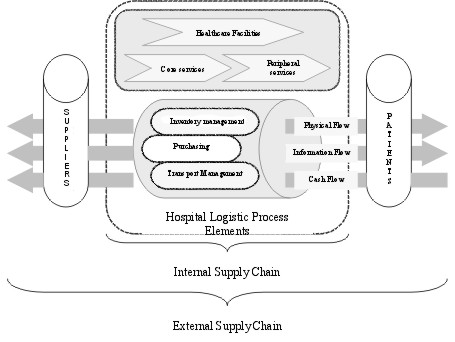|
|
|
INTERNAL AND EXTERNAL SUPPLY CHAIN OF HOSPITAL Izabela Dembińska-Cyran ABSTRACT The healthcare executives face increasing pressures to reduce costs and improve patient care. To accomplish this, many are reevaluating their organization's processes to enhance the effectiveness of their structure and procedures. In this paper, we look at the application of logistics approach to reorganizing of the internal and external hospital's supply chain, and how, through redesigning the structure and processes, the logistic cost can be reduced and quality service can be increase.
INTRODUCTION Currently, where the healthcare network is increasingly constrained by limited resources and mounting for efficiency, the global contribution of the logistics system performance can represent a significant for many gains. In this paper, we look at the application of logistics approach to reorganizing of the internal and external hospital's supply chain, and how, through redesigning the structure and processes, the logistic cost can be reduced and quality service can be increase. THE AREAS HEALTHCARE AND PHARMACEUTICAL LOGISTICS Today's healthcare executives face increasing pressures to reduce costs and improve patient care. To accomplish this, many are reevaluating their organization's logistic processes to enhance the effectiveness of their structure and procedures. Main areas of activity of healthcare and pharmaceutical logistics are:
Because, hospital logistics can still be fragmented, with little visibility over ordering, stock availability and status of supply chain activities, it is very important area of Healthcare and Pharma-ceutical Logistics, which needs integrated logistics management. HOSPITAL LOGISTICS A business-oriented management of hospital requires a realistic understanding of the complete logistic system. Hospital is the complex logistics network, composed typically of storerooms providing dozens of nursing units' stock locations with medical supplies. Add to this pharmaceuticals, office supplies, maintenance, food, leaning, sterilization, linen and waste, and this complex network can transform itself into a complicated logistics system. In fact, in hospital logistics cover not just support services such as purchasing, stores and the pharmacy, but also health care services such as patient care units and operating rooms. Hospital logistics can be defined as a large number of development, planning and implementation activities that subsequently facilitate more activities, such as purchasing, inventory management, transport management, the goods and services that form part of the overall medical service provided for the patients [www.triax.ca] (Fig. 1). According to definition of healthcare logistics, we have identified four major activities in hospi-tal logistics:
These activities have a target of the right item at the right place at the right time, every time, in the right quantity on the right costs.
INTEGRATION PROCESS OF THE INTERNAL AND EXTERNAL HOSPITAL SUPPLY CHAIN Studies have shown that from 30 to 46% of hospital expenses are invested in various logistical activities [Poulin], which translates into 27% being spent on supplies and equipment and 19% on labor. In addition it is estimated that nursing staff will spend on average 10% of their time performing logistics tasks instead of taking care of patients, which can not only have cost and care implications, but in countries where there is a shortage of healthcare professionals, social implications as well, such as stress related diseases [Landry, Philippe, 2002]. Of course almost half of the costs associated with supply chain processes could be eliminated through the implementation of better logistics management practices, particularly integration of the internal and external hospital supply chain. For example, in the United States, several of the larger hospitals have implemented point of use distribution methods over the last decade, where major distributors carry out all replenishment activities and deliver supplies directly to the point of use. Also knows as Stockless Material Management Programs, which, in healthcare, is rather scary expression, this Vendor Managed Replenishment (VMR) approach has many advantages, one of which is the removal of one link in the supply chain, the hospital's central storeroom. As you can see, hospitals need to engage more closely with suppliers to take greater responsibility for the delivery of products and services within the hospital environmental. Overall, integration is needed at these levels:
Figure 2 shows three primary stages in hospital supply chain management that result in improved performance. There is a progression to increasingly advanced approaches across the stages as complexity and value grow. These three stages illustrate how health care organizations such as hospital can take control of their supply chain and realize value by focusing both internally and externally. The integration process of the hospital supply chain is created when are consistent goals, processes, structures and sharing of information between departments and organisations.
The collaboration and partnerships in the supply chain is needed to release more value. The integration will realise great supply chain benefits which have a further positive impact on relationships between partners:
CASE STUDY - LOGISTICS IN THE JAPANESE AND CANADIAN HOSPITALS The Tokyo University Hospital, Japan [Landry, Beaulieu 2003] The Tokyo University Hospital is located on the main campus of the University of Tokyo. It is a public hospital. The hospital has 24 nursing units and a total of 1193 beds. (In Japan, a hospital is defined as a healthcare institution with more than 19 beds). The beds occupancy rate is approximately 92%, and the average stay is 17 days. It can also handle some 4000 patients per day in its outpatient clinic. A total of 3000 employees, including 500 doctors and 1000 interns or residents work at the hospital. The Tokyo University Hospital within the confines of logistics practices outsource its materials management activities - Supply, Processing and Distribution (SPD) - and boasts a highly automated transport system. (SPD can defining such a department within a hospital that creates a steady flow of supplies from the distribu-tion center to patients and personnel, recycles the supplies, and prepares them for redistribution). For daily procurement activities and receiving, stocking and replenishment of medical supplies, serums and pharmaceutical items on nursing units the service providers responsible. The SPD also manages an internal courier service that employs 8 people. A number of hiring freezes partially explain the decision to outsource to a third party. The SPD service and its some 60 employees operate three shifts 24 hours a day in order to respond to regular replenishment requests for nursing unit storerooms and requests scheduled according to future needs. Therefore, supplies are bundled into plastic bags together with a tag to identify the product, quantity and user department. Products delivered to nursing units are stored in their packaging in high-density vertical shelving systems located on the nursing unit itself. Approximately 200-250 items are stocked on nursing units. Nurses open a new package as required, removing the card and placing it in a container located at the entrance to the unit. These cards are collected each day by SPD personnel and delivered to stores to be scanned and destroyed. A new card is printed for the new packaging assembled in stores. This system is a variant of the two-bin method. Approximately 80% of products are delivered to nursing units by an automated transport system. This system is deployed in the tower and is made up of vertical conveyors able to stop at each floor. It transports bins in a variety of predetermined sizes and a total of 1600 high-density bins are used in hospital. The maximum transport time is about 27 minutes, with the system transporting both replenished product such as supplies, linens, serums, pharmaceutical items, and returns. The Royal Victoria Hospital in Montreal, Canada [Beaulieu, Duhame, Philippe 2003] The Royal Victoria Hospital (RVH) was founded in 1894. The hospital located in Montreal, Quebec, Canada maintains 680 beds. The hospital's budget is 150 million USD. In early 2001 hospital management decided to first disinfect six of the Operating Room's thirteen suites. However, because the tests that followed remained positive, management had no choice but to immediately close the Operating Room and launch a major decontamination program, which was scheduled to run over a 10-week period. The Operating Room is a key component of the hospital environmental. Activities carried out there are crucial and require the careful planning of personnel and material resources. The logistical reorganization of the Operating Room involved reengineering four axes:
Before the shutdown of the Operating Room, supplies (lines, common medical supplies, reusable instruments, direct purchase items) were stored in 37 different locations spread over 6 separate zones. The gathering of supplies needed for a surgery could necessitate a retrieval circuit involving up to 6 stops. According to Operating room staff, the preparation of a single case could take 15-45 minutes. It was necessary to work toward an increased centralization of storage areas. Therefore the number of main storage areas for all supplies and instruments was subsequently reduced to three: an area for specialized supplies and instruments, an area for common, multi-use supplies, and an area for non-sterile supplies. The new retrieval cycle involved no more than 3-4 stops over a smaller distance, which allowed the time required to prepare for cases to be cut in half. The next axis involved installing a new storage system for the various supplies which would allow a maximum amount of space to be used for storage while reducing the number of storage areas and centralizing as much as possible. A vertical high-density modular storage system was adopted which offered a great deal of flexibility. This system offers also complementary accessories, allowing it to be used on conjunction with the Double Bin replenishment method. The Double Bin method divides the supply quota for an item equally into two bins. Once the first or primary bin is empty, nursing or clerical staff remove the bar coded label and use supplies from the second or secondary bin. Labels are scanned according to a predetermined schedule. The information is transferred to the information system which generates the list of items required in the hospital's Central Stores. Presented arrangements brought the time required to manage the Operating Room's supply chain to more than 20 300 hours, resulting in annual costs of close to 590 000 USD. More than half of this time involved Nursing staff and prompted a number of experienced personnel to leave their job. REFERENCES Beaulieu M., Duhame C., Philippe R. 2003, A logistics approach to reorganizing an operating room. Working Paper No 03-07e. Duddy S., 2004, Better Healthcare through Leaner Logistics. "Logistics Europe". Landry P. S., Philippe R., 2002, 4U2C or how logistics can service healthcare. Ecole des Hautes Commerciales, Montreal, Quebec. Landry P. S., Beaulieu M., 2003, Healthcare logistics in Japan. Work. Pap. N 03-06e, HEC Montreal. Nagasawa Y., 2001, Hospital Development in Japan. Hospital engineering and facilities management. IFHE, London. Poulin E.: Benchmarking the hospital logistics process. http://www.managementmag.com//index.cfm/ci_id/1.htm#Top http://www.triax.ca/EN/master-lexique-01.html WEWNĘTRZNY I ZEWNĘTRZNY ŁAŃCUCH DOSTAW W SZPITALU
STRESZCZENIE
Ciągle zwiększająca się presja zmniejszania kosztów oraz poprawy opieki nad pacjentem jest wywierana na systemie opieki zdrowotnej. Aby temu sprostać, wiele placówek poddaje się reorganizacji w celu zwiększenia efektywności swoich struktur organizacynych i procedur. W pracy przedstawiono logistyczne podejście do reorganizacji wewnętrznego i zewnętrznego łańcucha zaopatrzenia szpitala. Wykazano, jak poprzez przemodelowanie struktury organizacyjnej, można osiągnąć redukcję kosztów logistycznych oraz poprawę jakości świadczonych usług. DIE INTERNE UND EXTERNE VERSORGUNG VON KRANKENHÄUSERN
ZUSAMMENFASSUNG.
Heute, da sich das Gesundheits-System ständig erweitert und das obwohl die Mittel knapp sind und daher effektiv eingesetzt werden müssen, kann die globale Logistik einen entscheidenden Beitrag für viele Ziele leisten. In diesem Artikel, werden wir die Herangehensweise der Logistik an die Reorganisation der internen und externen Krankenhaus-Versorgung sehen, als auch wie durch Neudesign der Strukturen und Prozesse, die Logistikkosten reduziert werden können und die Qualität des Services verbessert werden kann.
dr Izabela Dembińska-Cyran |
Copyright © 2005 LogForum, Wyższa Szkoła Logistyki, ul.E.Estkowskiego 6, tel. 061 852 95 55, 851 06 04, tel./fax. 061 851 06 03 |


